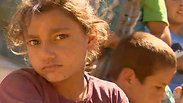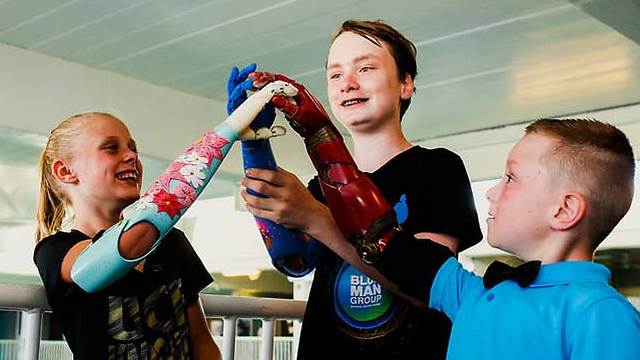
US NGO to send 75 bionic arms to Syrian children
Limbitless, founded by American graduate students, uses 3-D printers to make the limbs more cheaply; many Syrian children have lost limbs due to Syrian army's use of barrel bombs.
It is more dangerous to be a child in Syria than anywhere else in the world, according to the United Nations, which says that at least 5.5 million Syrian children have been affected by the conflict.
At least 12,000 children have been killed since the fighting began in Syria, according to the Syrian Observatory for Human Rights. More than 1.2 million children have become refugees, almost half of them under the age of five. Another three million are “internally displaced”, most of whom have not been to school for the past four years.
Then there are the children who have lost limbs in the conflict, often from “barrel bombs”, improvised barrel-shaped devices filled with explosives that the Syrian army has frequently used.
Now, Limbitless, an NGO founded by American graduate students, is raising money to send 75 bionic arms to Syrian children who have lost limbs. Limbitless, which uses 3-D printers to make the limbs, has already made nine devices for seven children in the US. Another 12 American children are due to get new limbs before Christmas.
Albert Manero, a graduate student at the University of Central Florida, and the director of Limbitless Solutions, says he was inspired to try to help Syrian children after learning of their plight from other organizations.
“It is easy to be unaware of the global challenges,” Manero told The Media Line. “However, when families and organizations continue to fill our inbox asking for help – and hope—we cannot stand by. We want to continue our work here in the USA and develop our capacity to support kids in need around the globe.”
The 3-D printer enables the limbs to be built cheaply and quickly. A hand takes 4-6 weeks to make, and a bionic arm without an elbow takes 8 – 12 weeks. The technology uses electromyography, meaning that when a child flexes his bicep it triggers a signal that allows the users to open and close his hand. An arm costs just $350, and as a child grows the plastic parts can be reprinted in a larger size for just a few dollars.
Insurance often will not pay for prosthetic devices for children, which can cost tens of thousands of dollars and need to be replaced as the child grows.
“He is a visionary and he has the compassion chip,” Jan Maren Innes, the founder of MedChild International told The Media Line. “He is just 25, but utterly brilliant, and he is bringing the cost of prosthetics down.”
MedChild is a non-profit that provides medical care in the US for children with special medical needs. Innes, who founded the organization, said well-meaning donors of prosthetic limbs often fail in the follow-through. Her organization aims to help children with medical care until they are 18.
She describes nine-year-old Ahmed, who had lost an arm in a barrel bomb in Syria two years ago, and whose family fled to Turkey. She asked that his last name not be used.
In June, Medchild International flew Ahmed and his father to Boston, where they will spend six months living with a Muslim host family. Her organization covers all expenses, including periodic consultations in the US until he turns 18.
“He’s an incredible little boy and has so much courage and perseverance,” she told The Media Line. “He is absolutely focused on making sure people understand what is happening in Syria.”
He frequently asks her how to help other children in Syria, she said, on the verge of tears.
The conflict in Syria shows no sign of ending and the number of dead and wounded keep rising. Both Limbitless and MedChild International can help only a few children at a time, but for those children, the aid is life-changing.
“We want to continue our work and develop our capability to support kids in need around the globe,” Manero said. “Every day we get better at our designs and productions.”
This article was published with the permission of The Media Line.













